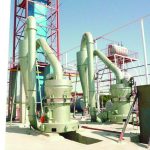| Nom: | Plâtre de Paris Plant | Capacité annuelle: | 30000-500000 Tonnes / an |
|---|---|---|---|
| Système de calcination: | Fournaise fulide, Four rotatif, Bouilloire | Type de carburant: | Charbon, Gaz naturel, Huile, Etc |
| Matière première: | Gypse Rock / Mine | Silo: | Fourni par l'acheteur |
| Installation: | Nous enverrons le technicien sur le site pour guider l'installation | Système de contrôle: | PLC Contrôle |
| Utilisations du produit fini: | Matériau de construction pour la construction | Service après-vente: |
Les matériaux de poudre qui proviennent de la mouture du processus de poudre ou du silo en poudre, Ils le feront par vertical, Convoyeur horizontal puis en mesure le convoyeur à vis dans un four à bouillir pour la calcination. Four à bouillir prendre l'huile de transfert de chaleur à haute température comme source de chaleur, L'huile de transfert de chaleur à haute température est fournie par chaudière à huile thermique à charbon. Lorsque l'huile de transfert à haute température pénètre, sa chaleur se transmettra à la poudre de gypse par échangeur de chaleur, et faire devenir Caso4 * 2H2O en caso4 * 1 / 2h2o (Bâtiment de gypse). Pendant la calcination, Nous ajustez la température de décharge en fonction de la quantité d'alimentation du gypse brut, Bâtiment calciné gypse décharge automatique continue de la fournaise bouillante, et sont transportés pour construire du silo de gypse passant à travers le convoyeur à vis et l'ascenseur de seau. Et l'huile de transfert de chaleur retournera le débit dans la chaudière à huile thermique à charbon pour réchauffer.

gypse
La brève introduction du gypse naturel
Le gypse naturel dihydraté (CASO4 · 2H2O) est également appelé gypse brut. Après calcination et broyage, β hémihydrate gypse (CASO4 · H2O), c'est, Bâtiment de gypse, être également connu sous le nom de plâtre de Paris et de boue de citron vert. La mine de gypse est principalement composée de dépôts sédimentaires, Et les réserves représentent plus que 90% du pays. Les mines de gypse métamorphique épigénétique et hydrothermale ne sont pas très importantes. Les mines de gypse ont été produites à tous les âges, avec les dépôts de gypse sédimentaire du Crétacé et du tertiaire étant le plus important.
Le gypse naturel le plus utilisé est le gypse dihydraté, dont l'ingrédient actif est le sulfate de calcium dihydraté. En général, Le gypse est classé en fonction de la teneur en dihydrate de sulfate de calcium dans le minerai. Le gypse a un large champ d'application et de nombreux types de produits. Différents usages ont des exigences différentes sur la qualité des matières premières de gypse. Le gypse de haut niveau est principalement utilisé dans la production de produits de gypse spéciaux tels que comestible, médical, art, Modèles et charges chimiques, etc.; Le minerai de gypse avec une teneur en sulfate de calcium de moins que 60% est rarement utilisé; plus que 60% du minerai de gypse est utilisé dans divers domaines tels que les matériaux de construction et la construction, etc., Selon son contenu.
Capacité de la ligne de production de poudre de gypse naturelle naturelle
| tonne / an | tonne / heure | Ton de consommation de pierre de gypse / année | Chauffage du chauffage
|
Ressource thermique |
| 20,000 | 2.78 | 24,000 | Huile thermique, Air chaud, Vapeur |
Charbon, Gaz naturel, Huile légère, Huile lourde, Biomasse, Vapeur |
| 30,000 | 4.12 | 36,000 | ||
| 40,000 | 5.56 | 48,000 | ||
| 60,000 | 8.24 | 72,000 | ||
| 80,000 | 11.11 | 96,000 | ||
| 100,000 | 13.88 | 120,000 | ||
| 150,000 | 20.83 | 180,000 | ||
| 200,000 | 27.78 | 240,000 | ||
| 30,0000 | 41.66 | 360,000 |
DESCRIPTION DE PROCESSUS DE PRODUCTION DE GYPSUM NATUREL
La pierre de gypse est envoyée du tas de matières premières à la matériau recevant de la trémie en acier par le chargeur, et la grande pierre de gypse est écrasée par le concasseur pour atteindre la taille des particules requise du processus, et le matériau qui répond aux exigences de la taille des particules est stocké dans le silo de stockage des matières premières via le dispositif de transport. Les petits matériaux sont transportés par la mesure au moulin pour broyer, et les matériaux de bloc seront broyés en poudre dans le moulin pour atteindre la finesse requise du processus. La poudre est transportée dans le silo tampon à travers le dispositif de transport pour la mise en mémoire tampon. Alors, La poudre est uniformément transmise à l'équipement de calcination de la poudre de gypse à travers le dispositif d'alimentation de la mesure, et la poudre de gypse terminera la conversion du gypse dihydraté au gypse hémihydraté. Une fois la calcination terminée, il est modifié par le moulin à boule, refroidi par la glacière , puis transporté dans l'entrepôt de produit fini à travers l'équipement de transport pour le stockage et le vieillissement.

 Hebei Lvjoe Machinery Development Co., Ltd
Hebei Lvjoe Machinery Development Co., Ltd














